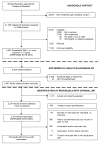The rising prevalence of chronic low back pain
- PMID: 19204216
- PMCID: PMC4339077
- DOI: 10.1001/archinternmed.2008.543
The rising prevalence of chronic low back pain
Abstract
Background: National or state-level estimates on trends in the prevalence of chronic low back pain (LBP) are lacking. The objective of this study was to determine whether the prevalence of chronic LBP and the demographic, health-related, and health care-seeking characteristics of individuals with the condition have changed over the last 14 years.
Methods: A cross-sectional, telephone survey of a representative sample of North Carolina households was conducted in 1992 and repeated in 2006. A total of 4437 households were contacted in 1992 and 5357 households in 2006 to identify noninstitutionalized adults 21 years or older with chronic (>3 months), impairing LBP or neck pain that limits daily activities. These individuals were interviewed in more detail about their health and health care seeking.
Results: The prevalence of chronic, impairing LBP rose significantly over the 14-year interval, from 3.9% (95% confidence interval [CI], 3.4%-4.4%) in 1992 to 10.2% (95% CI, 9.3%-11.0%) in 2006. Increases were seen for all adult age strata, in men and women, and in white and black races. Symptom severity and general health were similar for both years. The proportion of individuals who sought care from a health care provider in the past year increased from 73.1% (95% CI, 65.2%-79.8%) to 84.0% (95% CI, 80.8%-86.8%), while the mean number of visits to all health care providers were similar (19.5 [1992] vs 19.4 [2006]).
Conclusions: The prevalence of chronic, impairing LBP has risen significantly in North Carolina, with continuing high levels of disability and health care use. A substantial portion of the rise in LBP care costs over the past 2 decades may be related to this rising prevalence.
Conflict of interest statement
None of the authors have any relevant financial interests or financial conflicts related to this work.
Comment in
-
Low back pain in VA users.Arch Intern Med. 2009 Jul 27;169(14):1338-9; author reply 1339. doi: 10.1001/archinternmed.2009.201. Arch Intern Med. 2009. PMID: 19636039 No abstract available.
References
-
- From the Centers for Disease Control and Prevention. Prevalence of disabilities and associated health conditions among adults--United States, 1999. JAMA. 2001;285(12):1571–1572. - PubMed
-
- Stewart WF, Ricci JA, Chee E, Morganstein D, Lipton R. Lost productive time and cost due to common pain conditions in the US workforce. JAMA. 2003;290(18):2443–2454. - PubMed
-
- Ricci JA, Stewart WF, Chee E, Leotta C, Foley K, Hochberg MC. Back pain exacerbations and lost productive time costs in United States workers. Spine. 2006;31(26):3052–3060. - PubMed
-
- Katz JN. Lumbar disc disorders and low-back pain: socioeconomic factors and consequences. J Bone Joint Surg Am. 2006;88(Suppl 2):21–24. - PubMed
Publication types
MeSH terms
Grants and funding
LinkOut - more resources
Full Text Sources
Other Literature Sources
Medical
Miscellaneous


